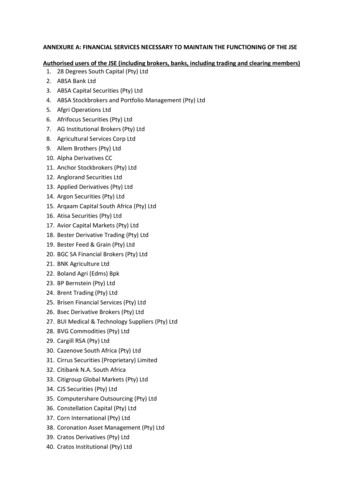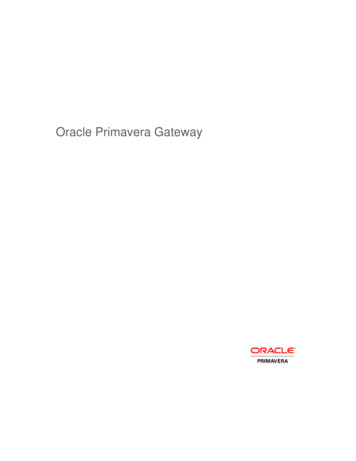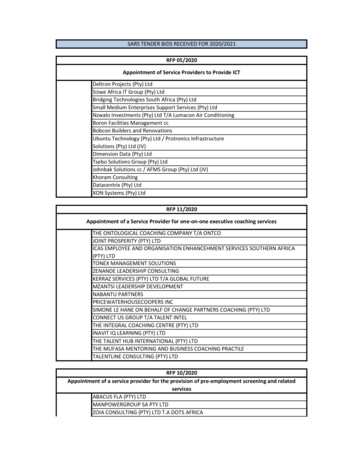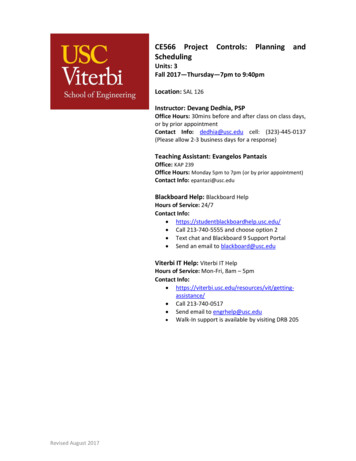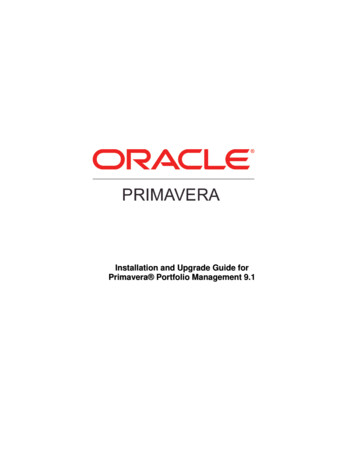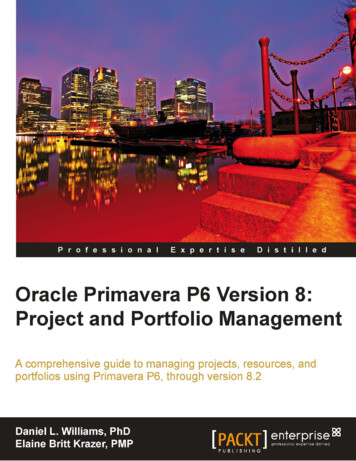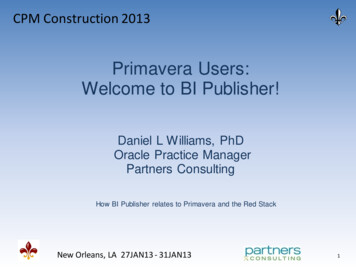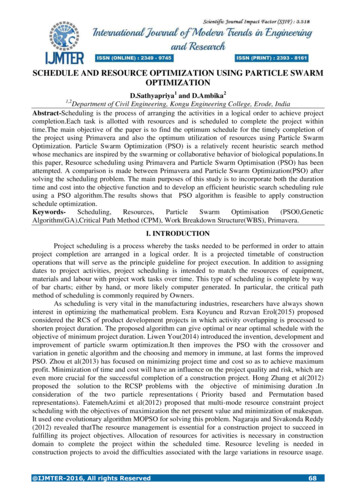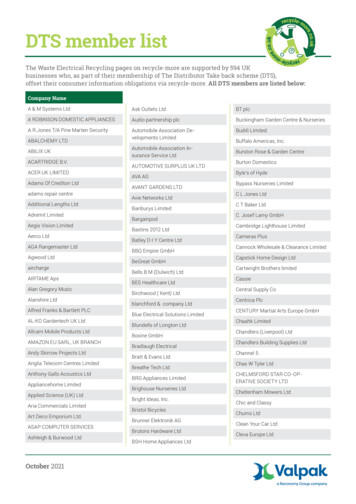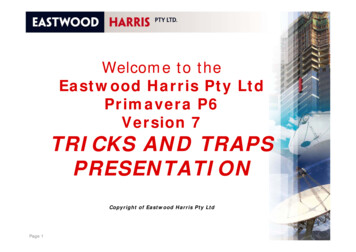
Transcription
Welcome to theEastwood Harris Pty LtdPrimavera P6Version 7TRICKS AND TRAPSPRESENTATIONCopyright of Eastwood Harris Pty LtdPage 1
Purpose of the Presentation To demonstrate the P6 Version 7 bars functions, and To suggest some solutions for bar formatting issues.issuesPage 2
T iTopicsTRICKY P6 FUNCTIONS Float on a Completed Activities Relationships on a Baseline Bar How to Create a Summary Bar Negative Float on a Complete Activity Why is Negative Float showing when it should not Summary Duration Calculations Baseline Bar showing when no baseline is setTECHNIQUES BBarswithoutith t SuccessorsSare criticaliti l Multiple Project Float Calculation Start or End Float Activity Durations with ResourcesPage 3
FLOAT ON A COMPLETED ACTIVITY By default a Total Float bar is displayed on acompleted task, but the Float value is set to “Null”,this is not logical:Page 4
FLOAT ON A COMPLETED ACTIVITY To remove this set the filter on the Float Bar in the inthe Bars form to be Not Started or In Progress:Page 5
FLOAT ON A COMPLETED ACTIVITYPage 6
RELATIONSHIPS ON A BASELINEBAR To remove relationships on the Baseline bar, move into the Baseline bars to the bottom of the Bars form:Page 7
HOW DO YOU CREATE ASUMMARY BAR To create a new summary bar you will see that youcan not select Summary from the filter drop downbox:Page 8
HOW DO YOU CREATE A SUMMARYBAR Open to the Bars form, Bar Settings tab and selectShow bar for grouping bands:Page 9
NEGATIVE FLOAT IS SHOWINGWHEN IT SOULD NOT Why do I have one day Negative Float:Page 10
NEGATIVE FLOAT SHOULD NOTBE SHOWING AlAlways showhththe timetiwhenhschedulingh d lias P6 doesdnotthave a default start or finish time and often selects00:00 as the time when setting actuals or constraints:Page 11
A GAP BETWEEN THE DATADATE AND ACTIVITY BAR When an activity is complete the Early Start andEarly Finish are set to the Data Date, 12 Oct atg , NOT to the Actual Start as in manyy othermidnight,products, When an activity is in progress the Early Start is setto the Activity calendar Start Date and Time NOT tothe Actual Start as in many other products. To pprevent this stet the Data Date to the ActivityyCalendar Start Date:Page 12
HOW DO SUMMARY DURATIONSCALCULATE What Bars are these?Page 13
Database Default CalendarCalendar, WBS andProject Durations – Version 6.2 & Earlier ThThe ddurationstioff allll bandsb d suchh as PProject,j t WBS,WBS anddResources are calculated from: The Database Default Calendar and The Hours/Day setting in the Edit, UserPreferences , Time Units tab. The following picture show the duration of theworkshop used in this publication set at firstly 5 daysper week,peee , 8 hoursou s perpe day anda d a durationdu at o ofo 35 dayswith an Hours/Day setting of 8 hours.Page 14
Database Default CalendarCalendar, WBS andProject Durations – Version 6.2 & Earlier NNow withith theth DefaultD f lt CalendarC l dchangedhd tto a 7day/week 24 hour per day the duration of 139 days isclearly misleading, The duration of the Project Summary WBS Nodes arealso clearly misleading, the Research Node is not 31days long.Page 15
Database Default CalendarCalendar, WBS andProject Durations – Version 6.2 & Earlier There are some issues that need to be carefullyconsidered when planning and controlling multipleprojects with different calendars in one databasewhen the correct durations in days are important,important Primavera performs best when the all calendars in allthe pprojectsjare set with the same hours pper day,y, If this is not possible you may consider: Showingg durations in hours only,y, Creating a separate database for projects that require adifferent hours per day, Not displaying the durations against Project nodes, WBSnodes and any other summary nodes by not checkingthe Show Group Totals in the Group and Sort form, Create a global change to put the correct duration in atext field.Page 16
CalculationCl l tioff ActivityA ti it DurationDtiiniDays – Version 7 In earlier version of P6 the calculation of thedurations in hours for all calendars was set either bythe Administrator in Admin,, Admin Preferences ,,Time Periods tab or by the User in the Edit, UserPreferences , Time Units tab. Primavera Version 7 hash removedd thesehtwo optionsabove and has created of a new calendar function foreach titled Hours per Time Period:Page 17
CalculationCl l tioff ActivityA ti it DurationDtiiniDays – Version 7 The picture below has the Project Default calendar setas the 8hr/d & 5d/w and the picture shows that whenthe calendars are different then the ProjectjDefaultcalendar is used to calculate the summary durationfor WBS Nodes, Projects etc:Page 18
A BASELINE BAR IS DISPLAYEDWHEN NO BASELINE SET This issue is due to the planned datesPage 19
PlPlannedd DatesD t The Planned Dates are very complex and theircalculationl l timethodth d iis outlinedtli d ini theth book,b k iinsummary: When an activity is Complete or In-progressIn progress theymatch the status of the schedule before the lastupdate,p When an activity has Not Started they match theEarly Start and Early Finish.Page 20
PlPlannedd DatesD tIssuesI The Planned Dates are dates that most schedulerswould not want displayed, These dates are displayed as the Project Baselinebars and Primary User Baseline bars when nobaseline has been assigned, You must be sure that all users set their PrimaryUser Baseline baselines before they display thebars.barsPage 21
BARS WITHOUT SUCCESSORSARE CRITICAL This is useful if you have not complete a schedule andneed to present it but do not want to show all thellongfloatfl t bbars whenhththe scheduleh d l hhas nott hadh d allll thethsuccessors added:Page 22
SchedulingSh d liOOptionsti– MakeM k OpenOEnds CriticalBar RefaeliPage 23
Make Open-ended Activities Critical Activities without a successor as displayed as criticalwhen they have floatfloat, this option makes the LateDates equal the Early Dates when an activity has nosuccessor. Open-ends Not Critical: Open-ends Critical:Page 24
CalculateCl l t floatfl t basedbd on finishfi i hdate ofNew to Primavera Version 6.2: Each project Opened projectsPage 25
Compute Total Float asThere are three options for this calculation: Start Float Late Start – Early Start Finish Float Late Finish – Early Finish Smallest of Start Float and Finish Float Note: It can be seen from the ppictures above that theTotal Float bar only displays the Finish Float.Page 26
Drive activity dates by default When this optionpis switched OFF it is ppossible for aresource to calculate outside the activity duration, When it is switched ON the resource durations areli k d tto thelinkedth activityti it duration:dtiPage 27
Activity Durations An Activity Duration is adopted from the longestRResourceDDuration,ti When more than one Resource has been assigned toan activity with different Units and/or Units/Time,Units/Time theResources many have different durations, In the following example the Activity Duration is 10days, which is calculated from David William’sResource Original Duration of 10 days:Page 28
Resource Lag A Resource may be assigned a Lag, the duration fromthe start of the activity to the point at which theResource commences work, In the following example the Activity Duration is 12days, which is calculated from Angela Lowe’sResource Original Lag of 7 days and ResourceO i i l DurationOriginalDtioff 5 days:dPage 29
COST MANAGEMENT USING WBSACTIVITIES AND EXPENSES P6 was developed without the ability to catch andcollect costs at WBS Node, Many software packages do collect costs at WBSNode which includes SAP, This section will outline how one can use WBSActivities and Expenses to manage costs collected byanother system and imported into P6.Page 30
Set Up the User Definable FieldsIn order to import cost at WBS Node I suggest: Create a WBS Activity in WBS Node to manage costs. Assign Costs to Expenses,Expenses then you will not run intoissues such as the Cost zeroing out when theRemaining Duration equals Zero as may happen withresources. P6 Expenses only have Budget, Actual, Remainingand At Completion cost fields.fields Costs have a number of elements, including Budget,Committed, Received, QQualityy Checked, Invoices,Outstanding Commitment against contracts andorders, Unallocated WBS funds (RemainingContingency).Page 31
Set Up the User Definable Fields –continued .To manage these cost fields: Set up Expense User Definable Fields to import thecosts into.into Costs in the Expense User Definable Fields maythen be Global Changedginto the appropriatepp pExpensepfield for reporting and comparing to the Baseline. Set up Activity User Definable Fields to import thecosts intoito displaydi ltheh costs ini columnslas ExpenseEUser Definable Fields may not be displayed in Gantchart columns. Both the Expense User Definable Fields and the ActivityUser Definable Fields are identical and the costs end upin three placesplaces, Expense CostsCosts, Expense User DefinableFields andPage 32
Set Up the User Definable Fields –continued .All the following fields contain the same costs: Expense User Definable Fields which hold all thedifferent types of costs and are used to import costsinto. ExpensepCosts fields which are ppopulatedpbyyaGlobal Change from the Expense User DefinableFields AActivityi i UserUDefinableD fi bl FieldsFi ld allowingll icosts to bebshow in Gantt Chart Columns.Page 33
Set Up the User Definable Fields –continued . SetS t up UserUDefinableD fi bl FieldsFi ld as per below,b l The Activity and Expense are identical, ThThe “PO” prefixfi kkeeps ththe orderd iin ththe databased t banddkeeps the fields together.Page 34
Set Up the User Definable Fields –continued .All the following fields contain the same costs: Expense User Definable Fields which hold all thedifferent types of costs and are used to import costsinto. ExpensepCosts fields which are ppopulatedpbyyaGlobal Change from the Expense User DefinableFields AActivityi i UserUDefinableD fi bl FieldsFi ld allowingll icosts to bebshow in Gantt Chart Columns.Page 35
Assign Expenses Assign Expenses against the WBS Activities with theirBudget and At Completion Costs, Baseline the project, Update the Activities.Page 36
EExporttheh UDS FieldsFi ld to ExcelEl Export the Activity and Expense UDF Fields to Excelto be populated and import, create a template as perbelow, Filter just on WBS Activities:Page 37
Update the Spread Sheet & Import The Activity and Expenses Spread Sheet will bothhave exactly the same fields, Populate one TASK sheet and Copy & Paste to thePROJCOST sheet, Import the data:Page 38
R iReviewDataD t Review the data, the costs should be assigned againstth ActivitytheA ti it UDFsUDF andd theth ExpenseEUDFs:UDFPage 39
GlobalGlb l ChChange UDF intoi t ExpenseEColumns Depending on what cost you want put where run aGlobal Change like the one below:Page 40
Review Data The UDF Values for Activities and Expenses should bethe same:Page 41
Presented byEastwood Harris Pty LtdSSupplierslioff PrimaveraP ianddMicrosoft Projectjbooks andtraining materialwww primavera com auwww.primavera.com.auwww.eh.com.auCopyright of Eastwood Harris Pty LtdPage 42
In earlier version of P6 the calculation of the durations in hours for all calendars was set either by the Administrator in Admin, Admin Preferences , Time Periods tab or by the User in the Edit, User Preferences , Time Units tab. Primavera Version 7 hdhhas removed these two options above and has created of a new calendar function for
